
Price based on lowest available cruise only fare for double occupancy. Subject to change at any time.
Discover Celebrity Solstice
Explore the beauty of Celebrity Solstice in these photo galleries, where you'll get a glimpse of her luxurious accommodations and welcoming venues. Browse through these Celebrity Solstice photos and start daydreaming about your next vacation aboard this award-winning ship.
Experience a vacation like no other aboard Celebrity Solstice. Relax and enjoy unforgettable spaces, world-class amenities, and all of the distinct features that make our cruises so extraordinary. Enjoy all of the award-winning onboard experiences as we make our way to incredible destinations. Our stylish accommodations include Concierge Class staterooms and spa-inspired AquaClass® with exclusive clean cuisine dining at Blu. The Retreat® experience includes private restaurant dining and 24/7 lounge. Enjoy dining options that include distinctive restaurants with menus crafted by Michelin-starred chef and the most awarded wine collection at sea. Play your favourite outdoor games, catch a concert, or just take in some sun at The Lawn Club. Invigorate your senses and discover an amazing level of soothing spa treatments at The Spa. Relax, rest, and recharge aboard Celebrity Solstice and we'll take care of every detail, so all you have to do is enjoy your vacation.
Celebrity Solstice is sailing with Starlink - the world's most advanced broadband satellite internet - to bring you high-speed connectivity for a better onboard experience.
Cruise ID: 10723
A service gratuity will be automatically applied to each guest's SeaPass® account on a daily basis for sailings*, excluding guests in Excluding Bookings.** Current amounts*** for the daily gratuity are listed below. The gratuities described above are distributed to the crew, such as dining, bar and culinary services staff, stateroom attendants and other hotel services teams, and others who work to enhance the overall cruise experience.
A 20% gratuity will be automatically added to spa and salon purchases and a 20% gratuity will also be automatically added to specialty dining, beverage, beverage package, room service and mini bar purchases.
Gratuities may be adjusted at the guest's discretion onboard at Guest Relations up until the morning of their departure.
* Guests sailing in group reservations should check with their group's leader or travel agent for details.
**Excluded Bookings include all staterooms booked either (i) at the All Included rate (formerly Always Included on or before October 4, 2023); or (ii) in the Retreat or AquaClass stateroom category from July 14, 2022, to October 4, 2023. Stateroom and restaurant service gratuities, and a 20% beverage package gratuity, are included in the fare of all guests in an Excluded Booking.
***Gratuity amounts are subject to change.
| Date | Time | Price * | Booking |
|---|---|---|---|
| 02 January 2025 | 17:30 | €1,563 | Call us to book |
* Price based on lowest available cruise only fare for double occupancy. Subject to change at any time.
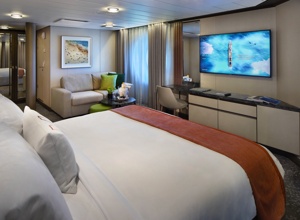
Take your Celebrity vacation to new heights in a Sky Suite. Be welcomed with a bottle of sparkling wine and enjoy the luxury of your butler throughout your stay. Plus enjoy exclusive access to dining and lounge areas reserved only for guests of The Retreat. Accessible Sky Suites available.
Perfectly designed Sky Suites offer a blend of expansive views and intimate luxury. These large suites feature our signature Cashmere™ Mattress with eXhale® bedding and a spacious, private veranda. Be welcomed with a bottle of sparkling wine and enjoy the luxury of your butler throughout your stay. Plus, enjoy access to Luminae and The Retreat Lounge, exclusive for guests of The Retreat.
Highlights
*Bed as large or larger than average standard international king-size bed.
Exclusive services and amenities
The best amenities, all included.*
As a guest of The Retreat, you'll also enjoy a long list of thoughtfully curated amenities that start with premium drinks and premium Wi-Fi, in addition to a private restaurant and exclusive lounge.
Premium Drinks | Enjoy your favorite beverages throughout the ship. Whether dining in our restaurants, out exploring, or relaxing by the pool.
Premium Wi-Fi | Always stay connected, no matter where you are, with complimentary unlimited Wi-Fi.
*Special fares and MoveUp upgrades from non-suite staterooms do not receive these amenities.
Services & amenities for Sky Suite guests
Intuitive Service
World-class cuisine
Thoughtfully curated amenities
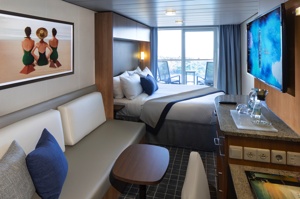
Solstice AquaClass guests enjoy a private veranda, Exhale® bedding, premium bathroom amenities, massaging showerhead and complimentary fitness classes. Plus, unlimited access to the Persian Garden, complimentary dining at Blu, and personal spa concierge.
Available on Celebrity Eclipse, Celebrity Equinox, Celebrity Reflection, Celebrity Silhouette & Celebrity Solstice
Wellness is so fundamental to our philosophy, we offer AquaClass® staterooms for a fully immersive, next-level wellness experience. Elements are thoughtfully infused throughout your stateroom. Savour clean cuisine, including new healthy options, at your exclusive restaurant, Blu. Plus, you'll enjoy access to the Persian Garden, a spa concierge, a complimentary fitness pass, preferential rates on AquaClass spa packages, daily in-room bottled water service, healthy room-service menu options, and a yoga mat for use on board. We've thought of everything so that you can focus on nourishing your mind, body, and spirit.
Spa Benefits
Amenities
Dining
AquaClass Features
*Additional charges apply
† $9.95 service fee and 20% gratuity may apply
**Bed as large or larger than average standard international king-size bed
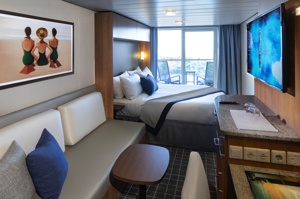
Little details make a world of difference, and now our meticulously thought out Concierge Class staterooms are even better. Featuring new services, amenities, and exclusive events, step inside and discover a space that is so much more than a room—it's an experience. As a Concierge Class guest, your team of dedicated professionals will take care of all your vacation needs.
Amenities
Stateroom Features
Services
Dining
*Additional charges apply
**Bed as large or larger than average standard international king-size bed
† $9.95 service fee and 20% gratuity may apply
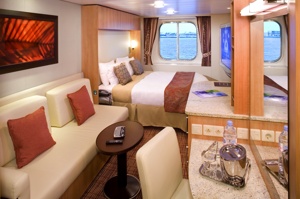
Ocean View staterooms, the ideal place to unwind at sea. These perfectly indulgent spaces come furnished with Celebrity's eXhale® bedding featuring the luxury king sized* mattress and everything else a modern traveler needs.
Amenities
Stateroom Features
Services
Dining
*Additional charges apply
**Bed as large or larger than average standard international king-size bed
† $9.95 service fee and 20% gratuity may apply
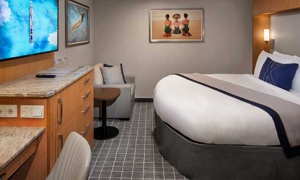
Your escape at sea, Inside staterooms offer ample living space, including a sitting area and a flat screen TV. Each inside stateroom on board Celebrity includes world-class amenities. Prime Inside staterooms are well-appointed, personal retreats located in the most-desirable locations on the ship.
Amenities
Stateroom Features
Services
Dining
*Additional charges apply
**Bed as large or larger than average standard international king-size bed
† $9.95 service fee and 20% gratuity may apply
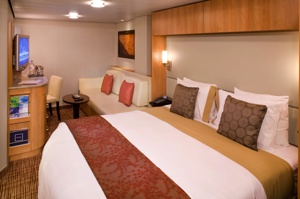
Your escape at sea, Inside staterooms offer ample living space, including a sitting area and a flat screen TV. Each inside stateroom on board Celebrity includes world-class amenities.
Amenities
Stateroom Features
Services
Dining
*Additional charges apply
**Bed as large or larger than average standard international king-size bed
† $9.95 service fee and 20% gratuity may apply
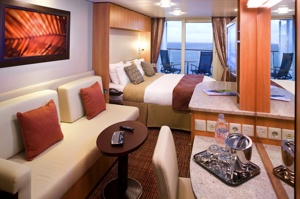
Indoor and outdoor space come together to create your private sanctuary at sea. Relax in a spacious stateroom and enjoy amenities that all contribute to your luxury experience. Your personal veranda lets you greet the day and enjoy fresh sea breezes.
Amenities
Stateroom Features
Services
Dining
*Additional charges apply
**Bed as large or larger than average standard international king-size bed
† $9.95 service fee and 20% gratuity may apply
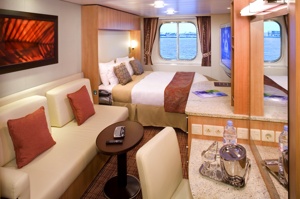
Expansive views make Ocean View staterooms the ideal place to unwind at sea. These perfectly indulgent spaces come furnished with Celebrity's eXhale® bedding featuring the luxury king sized* mattress and everything else a modern traveler needs. Prime Ocean View staterooms are well-appointed, personal retreats located in the most-desirable locations on the ship.
Amenities
Stateroom Features
Services
Dining
*Additional charges apply
**Bed as large or larger than average standard international king-size bed
† $9.95 service fee and 20% gratuity may apply
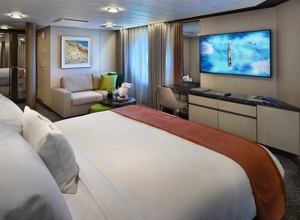
Wellness is so fundamental to our philosophy, we've created a whole new way to nourish your mind and body. Aqua Sky Suites combine the best of our rejuvenating AquaClass® experience with the ultimate luxury of The Retreat®. These suites feature a king-sized** bed with exclusive eXhale® bedding and a spacious, private veranda. Spa-inspired elements are thoughtfully infused throughout, including eco-friendly bathroom products, yoga mats, in-stateroom fitness amenities, and daily bottled water service, and an enhanced air filtration system—which you'll now find in all our staterooms. Aqua Sky Suite debut on Celebrity Solstice in April 2023.
Highlights
Exclusive services and amenities
The best amenities, all included.*
As a guest of The Retreat, you'll also enjoy a long list of thoughtfully curated amenities that start with premium drinks and premium Wi-Fi, in addition to a private restaurant and exclusive lounge.
Premium Drinks | Enjoy your favorite beverages throughout the ship. Whether dining in our restaurants, out exploring, or relaxing by the pool.
Premium Wi-Fi | Always stay connected, no matter where you are, with complimentary unlimited Wi-Fi.
*Special fares and MoveUp upgrades from non-suite staterooms do not receive these amenities.
Services & amenities for Aqua Sky Suite guests
Intuitive Service
World-class cuisine
Thoughtfully curated amenities
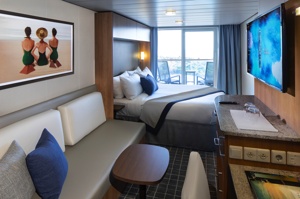
Little details make a world of difference, and now our meticulously thought out Concierge Class staterooms are even better. Featuring services, amenities, and exclusive events, step inside and discover a space that is so much more than a room—it's an experience. As a Concierge Class guest, your team of dedicated professionals will take care of all your vacation needs.
*Imagery of Revolutionized Celebrity Silhouette.
Amenities
Stateroom Features
Services
Dining
*Additional charges apply
**Bed as large or larger than average standard international king-size bed
† $9.95 service fee and 20% gratuity may apply
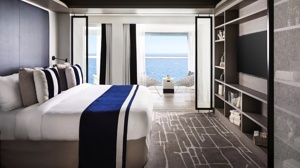
Unwind in modern spaces that will make you feel on top of the world. Relax in ultimate luxury on your private veranda.Lounge in the king-size Cashmere™ Mattress in your bedroom. Enjoy VIP treatment with your butler, expansive lounge areas and much more.
Our Penthouse Suites feature a primary bedroom, bathroom, dining area, guest bedroom and bathroom, terrace, and private hot tub. They even have an attentive butler on hand to ensure you never have to lift a finger during your vacation.
Highlights
*Bed as large or larger than average standard international king-size bed.
Exclusive services and amenities
The best amenities, all included.*
As a guest of The Retreat, you'll also enjoy a long list of thoughtfully curated amenities that start with premium drinks and premium Wi-Fi, in addition to a private restaurant and exclusive lounge.
Premium Drinks | Enjoy your favorite beverages throughout the ship. Whether dining in our restaurants, out exploring, or relaxing by the pool.
Premium Wi-Fi | Always stay connected, no matter where you are, with complimentary unlimited Wi-Fi.
*Special fares and MoveUp upgrades from non-suite staterooms do not receive these amenities.
Services & amenities for Penthouse Suite guests
Intuitive Service
World-class cuisine
Thoughtfully curated amenities
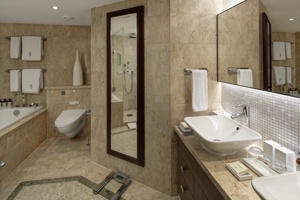
With spaces fit for a king or queen, our Royal Suites deliver on style and comfort. Separate living, dining, and sleeping areas provide all the room you need to relax in luxury.
Unwind in a luxuriously large living area featuring floor to ceiling panoramic windows. The Royal Suite features our luxury Cashmere™ Mattress, a primary bathroom with a large soaking tub, a separate shower, a double sink vanity, and a spacious private veranda. No matter where you are in this suite, you'll enjoy stunning views of the sea, the way every royal should.
Highlights
*Bed as large or larger than average standard international king-size bed.
Exclusive services and amenities
The best amenities, all included.*
As a guest of The Retreat, you'll also enjoy a long list of thoughtfully curated amenities that start with premium drinks and premium Wi-Fi, in addition to a private restaurant and exclusive lounge.
Premium Drinks | Enjoy your favorite beverages throughout the ship. Whether dining in our restaurants, out exploring, or relaxing by the pool.
Premium Wi-Fi | Always stay connected, no matter where you are, with complimentary unlimited Wi-Fi.
*Special fares and MoveUp upgrades from non-suite staterooms do not receive these amenities.
Intuitive Service
World-class cuisine
Thoughtfully curated amenities
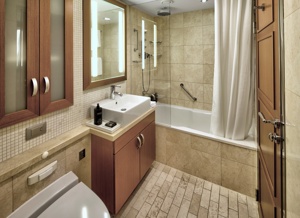
It's time you got the Celebrity treatment. Your butler will assist you at every step and you'll receive exclusive restaurant and lounge access.
These two-room suites feature a large living area with floor to ceiling panoramic windows, private veranda, and a primary bedroom with a king-size bed featuring our signature eXhale® bedding and Cashmere™ Mattress. When you stay in a Celebrity Suite, you'll enjoy the luxury of a butler. This includes assistance with unpacking and packing. In-suite lunch and dinner service. Afternoon tea. Evening hors d'oeuvres and complimentary in-suite specialty coffees from Café al Bacio.
Highlights
*Bed as large or larger than average standard international king-size bed.
Exclusive services and amenities
The best amenities, all included.*
As a guest of The Retreat, you'll also enjoy a long list of thoughtfully curated amenities that start with premium drinks and premium Wi-Fi, in addition to a private restaurant and exclusive lounge.
Premium Drinks | Enjoy your favorite beverages throughout the ship. Whether dining in our restaurants, out exploring, or relaxing by the pool.
Premium Wi-Fi | Always stay connected, no matter where you are, with complimentary unlimited Wi-Fi.
*Special fares and MoveUp upgrades from non-suite staterooms do not receive these amenities.
Intuitive Service
World-class cuisine
Thoughtfully curated amenities
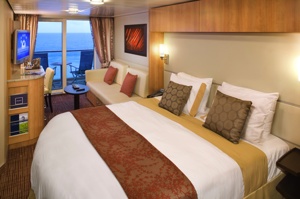
Your personal veranda lets you greet the day, enjoy fresh sea breezes, and soak in breathtaking sunsets.
Spacious staterooms located in the aft of the ship, each with its own private veranda to enjoy the beautiful sunsets. Sunset Veranda staterooms offer superb ocean views at the stern of the ship. Your personal veranda lets you greet the day, enjoy fresh sea breezes, and soak in breathtaking sunsets.
Amenities
Stateroom Features
Services
Dining
*Additional charges apply
**Bed as large or larger than average standard international king-size bed
† $9.95 service fee and 20% gratuity may apply
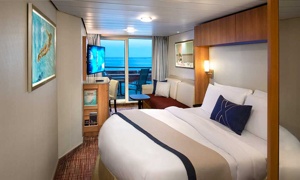
By far the largest stateroom with a veranda - plenty of room for you and the family.
Ample indoor and outdoor space come together to create your private sanctuary at sea. Your personal veranda lets you greet the day, enjoy fresh sea breezes, and soak in breathtaking sunsets.
Amenities
Stateroom Features
Services
Dining
*Additional charges apply
**Bed as large or larger than average standard international king-size bed
† $9.95 service fee and 20% gratuity may apply
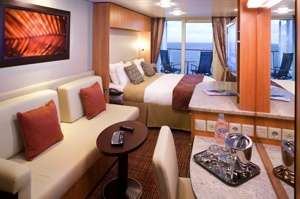
Ample indoor and outdoor space come together to create your private sanctuary at sea. Relax on your spacious veranda and enjoy amenities that all contribute to your luxury experience. Your personal veranda lets you greet the day and enjoy fresh sea breezes.
Amenities
Stateroom Features
Services
Dining
*Additional charges apply
**Bed as large or larger than average standard international king-size bed
† $9.95 service fee and 20% gratuity may apply
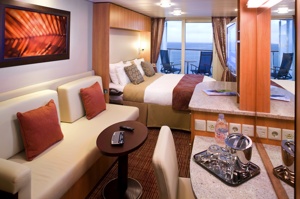
Indoor and outdoor space come together to create your private sanctuary at sea. Relax in a spacious stateroom and enjoy amenities that all contribute to your luxury experience. Prime Veranda staterooms are well-appointed, personal retreats located in the most-desirable locations on the ship.
Amenities
Stateroom Features
Services
Dining
*Additional charges apply
**Bed as large or larger than average standard international king-size bed
† $9.95 service fee and 20% gratuity may apply
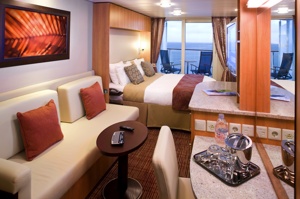
Ample indoor and outdoor space come together to create your private sanctuary at sea. Relax on your spacious veranda and enjoy amenities that all contribute to your luxury experience. Your personal veranda lets you greet the day and enjoy fresh sea breezes.
Amenities
Stateroom Features
Services
Dining
*Additional charges apply
**Bed as large or larger than average standard international king-size bed
† $9.95 service fee and 20% gratuity may apply
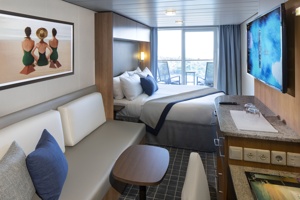
Little details make a world of difference, and now our meticulously thought out Prime Concierge Class staterooms are even better. Prime Concierge staterooms are well-appointed, personal retreats located in the most-desirable locations on the ship. Featuring services, amenities, and exclusive events, step inside and discover a space that is so much more than a room—it's an experience. As a Concierge Class guest, your team of dedicated professionals will take care of all your vacation needs.
*Imagery of Revolutionized Celebrity Silhouette.
Amenities
Stateroom Features
Services
Dining
*Additional charges apply
**Bed as large or larger than average standard international king-size bed
† $9.95 service fee and 20% gratuity may apply
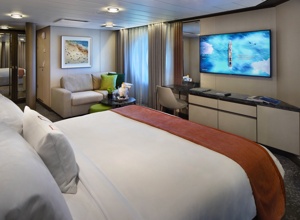
Take your Celebrity vacation to new heights in a Sky Suite. Be welcomed with a bottle of sparkling wine and enjoy the luxury of your butler throughout your stay. Plus enjoy exclusive access to dining and lounge areas reserved only for guests of The Retreat. Accessible Sky Suites available.
The perfectly designed Sky Suite offers a blend of expansive views and intimate luxury. These large suites feature a king-sized* bed with our signature eXhale® bedding and a spacious, private veranda. Be welcomed with a bottle of sparkling wine and enjoy the luxury of your butler throughout your stay. Plus, enjoy access to Luminae and The Retreat Lounge, exclusive for guests of The Retreat.
Highlights
*Bed as large or larger than average standard international king-size bed.
Exclusive services and amenities
The best amenities, all included.*
As a guest of The Retreat, you'll also enjoy a long list of thoughtfully curated amenities that start with premium drinks and premium Wi-Fi, in addition to a private restaurant and exclusive lounge.
Premium Drinks | Enjoy your favorite beverages throughout the ship. Whether dining in our restaurants, out exploring, or relaxing by the pool.
Premium Wi-Fi | Always stay connected, no matter where you are, with complimentary unlimited Wi-Fi.
*Special fares and MoveUp upgrades from non-suite staterooms do not receive these amenities.
Services & amenities for Sky Suite guests
Intuitive Service
World-class cuisine
Thoughtfully curated amenities
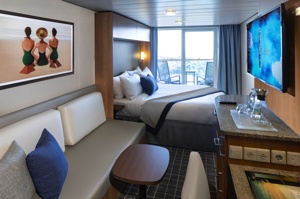
Solstice AquaClass guests enjoy a private veranda, Exhale® bedding, premium bathroom amenities, massaging showerhead and complimentary fitness classes. Plus, unlimited access to the Persian Garden, complimentary dining at Blu, and personal spa concierge.
Available on Celebrity Eclipse, Celebrity Equinox, Celebrity Reflection, Celebrity Silhouette & Celebrity Solstice
Wellness is so fundamental to our philosophy, we offer AquaClass® staterooms for a fully immersive, next-level wellness experience. Prime AquaClass staterooms are well-appointed, personal retreats located in the most-desirable locations on the ship. Savour clean cuisine, including new healthy options, at your exclusive restaurant, Blu. Plus, you'll enjoy access to the Persian Garden, a spa concierge, a complimentary fitness pass, preferential rates on AquaClass spa packages, daily in-room bottled water service, healthy room-service menu options, and a yoga mat for use on board. We've thought of everything so that you can focus on nourishing your mind, body, and spirit.
Spa Benefits
Amenities
Dining
AquaClass Features
*Additional charges apply
† $9.95 service fee and 20% gratuity may apply
**Bed as large or larger than average standard international king-size bed
Day 1 Hong Kong, Hong Kong
The Hong Kong Island skyline, with its ever-growing number of skyscrapers, speaks to ambition and money. Paris, London, even New York were centuries in the making, while Hong Kong's towers, bright lights, and glitzy shopping emporia weren't yet part of the urban scene when many of the young investment bankers who fuel one of the world's leading financial centers were born. Commerce is concentrated in the glittering high-rises of Central, tucked between Victoria Harbor and forested peaks on Hong Kong Island's north shore. While it's easy to think all the bright lights are the sum of today's Hong Kong, you need only walk or board a tram for the short jaunt west into Western to discover a side of Hong Kong that is more traditionally Chinese but no less high-energy. You'll discover the real Hong Kong to the east of Central, too, in Wan Chai, Causeway Bay, and beyond. Amid the residential towers are restaurants, shopping malls, bars, convention centers, a nice smattering of museums, and—depending on fate and the horse you wager on—one of Hong Kong's luckiest or unluckiest spots, the Happy Valley Racecourse. Kowloon sprawls across a generous swath of the Chinese mainland across Victoria Harbour from Central. Tsim Sha Tsui, at the tip of Kowloon peninsula, is packed with glitzy shops, first-rate museums, and eye-popping views of the skyline across the water. Just to the north are the teeming market streets of Mong Kok and in the dense residential neighborhoods beyond, two of Hong Kong's most enchanting spiritual sights, Wong Tai Sin Temple and Chi Lin Nunnery. As you navigate this huge metropolis (easy to do on the excellent transportation network), keep in mind that streets are usually numbered odd on one side, even on the other. There's no baseline for street numbers and no block-based numbering system, but street signs indicate building numbers for any given block.
Day 2 Cruising
Day 3 Ha Long Bay, Vietnam
A visit to the north is not complete without a trip to Halong Bay, where placid waters give way to more than 3,000 limestone karsts and wind-sculpted limestone formations that jut from foggy lagoons. Dotting the bay are tiny islands bordered by white sandy coves and hidden caves, adding to the majestic landscape of this UNESCO World Heritage Site. Adding to this naturalist's dream is the biodiversity of islets, grottos, and Cat Ba Island National Park. The bay, however, shows tourism's impact: the clearing of mangrove forests to make way for jetties and piers, marine life threatened by game fishing, and garbage from passenger boats and fishing villages washed up on the shores.Beyond its geological uniqueness are activities like hiking, kayaking, rock climbing, or exploring one of the many floating villages where fishermen bring in their daily catch. The downside to all this allure is the large number of unlicensed boats it draws to the bay each day.Boat trips out onto the bay are the main tourism stock in trade farther north, but a more multifaceted side of the area can be experienced at Cat Ba Island. The largest island in Halong Bay, Cat Ba is very much its own entity. Its national park offers incredible biodiversity, with more than a thousand species of plants having been recorded here. Animal life is slightly thinner on the ground, but alert visitors may spy inhabitants such as the endangered golden-headed langur, wild boar, deer, civets, and several species of squirrel. Trekking through the wilderness is a highlight with a number of fascinating trails to follow.Cat Ba Island has also become a firm favorite with the adventure sports set. Indeed, along with Railay Beach in Thailand, it is recognized as one of the top spots in the region for rock climbing. Other outdoor pursuits include sailing and kayaking around the karsts. Although Halong Bay has arguably been tainted by over-exposure, Bai Tu Long Bay farther east toward China, retains all the majesty of Vietnam's premier bucket-list natural attraction but sees a fraction of the traffic of its immediate neighbor to the west. Here, visitors will find islands of substantial size with deserted beaches and untamed jungle. Halong Bay's 3,000 islands of dolomite and limestone cover a 1,500-square-km (580-square-mile) area, extending across the Gulf of Tonkin nearly to the Chinese border. According to legend, this breathtaking land- and seascape was formed by a giant dragon that came barreling out of the mountains toward the ocean—hence the name (Halong translates into "descent of the dragon"). Geologists are more likely to attribute the formations to sedimentary limestone that formed here between 300 and 500 million years ago, in the Paleozoic Era. Over millions of years water receded and exposed the limestone to wind, rain, and tidal erosion.Today the limestone formations are exposed to hordes of tourists—but don't let that discourage you. Hundreds of fishing trawlers and tour boats share space on these crystal waters, yet there seems to be room for everyone. Most people use the main population center, Halong City, as a base from which to venture into the bay. Although it's now officially one municipality, Halong City was, until 1996, two separate towns: Bai Chay is now Halong City West, where Halong Road winds its way around the coast and past the lifeless central beach; Hon Gai is the grimier Halong City East, where a coal transportation depot dominates the center of town and covers nearby roads and buildings with a sooty film. Locals still refer to the towns by their old names, but they are now inexorably lassoed together by a bridge. Boat trips through Halong Bay are the main attraction. Little of the majesty of this region can be found in the city, so head out onto the water and start exploring. Countless 10- and 30-foot fishing boats have been converted into Halong Bay's formidable tourist-boat fleet. Hotels or travel agencies in Halong City or Hanoi can arrange boat trips for you (often they are part of organized tours from Hanoi). It is still possible to go down to the wharf and bargain yourself onto a boat for the day, but you are likely to be charged (sometimes significantly) more than you would pay for a prebooked tour, so this is not advised. Self-sufficient travelers have fallen victim to the old bait-and-switch: they've arranged a next-day boat tour with local fishermen, only to be told in no uncertain terms the following morning that they could not board their chosen boat, but they could take a different one for quite a bit more money. You may have no choice in the end. Usually travel agencies, however, have their tried-and-true favorites.
Day 4 Ha Long Bay, Vietnam
A visit to the north is not complete without a trip to Halong Bay, where placid waters give way to more than 3,000 limestone karsts and wind-sculpted limestone formations that jut from foggy lagoons. Dotting the bay are tiny islands bordered by white sandy coves and hidden caves, adding to the majestic landscape of this UNESCO World Heritage Site. Adding to this naturalist's dream is the biodiversity of islets, grottos, and Cat Ba Island National Park. The bay, however, shows tourism's impact: the clearing of mangrove forests to make way for jetties and piers, marine life threatened by game fishing, and garbage from passenger boats and fishing villages washed up on the shores.Beyond its geological uniqueness are activities like hiking, kayaking, rock climbing, or exploring one of the many floating villages where fishermen bring in their daily catch. The downside to all this allure is the large number of unlicensed boats it draws to the bay each day.Boat trips out onto the bay are the main tourism stock in trade farther north, but a more multifaceted side of the area can be experienced at Cat Ba Island. The largest island in Halong Bay, Cat Ba is very much its own entity. Its national park offers incredible biodiversity, with more than a thousand species of plants having been recorded here. Animal life is slightly thinner on the ground, but alert visitors may spy inhabitants such as the endangered golden-headed langur, wild boar, deer, civets, and several species of squirrel. Trekking through the wilderness is a highlight with a number of fascinating trails to follow.Cat Ba Island has also become a firm favorite with the adventure sports set. Indeed, along with Railay Beach in Thailand, it is recognized as one of the top spots in the region for rock climbing. Other outdoor pursuits include sailing and kayaking around the karsts. Although Halong Bay has arguably been tainted by over-exposure, Bai Tu Long Bay farther east toward China, retains all the majesty of Vietnam's premier bucket-list natural attraction but sees a fraction of the traffic of its immediate neighbor to the west. Here, visitors will find islands of substantial size with deserted beaches and untamed jungle. Halong Bay's 3,000 islands of dolomite and limestone cover a 1,500-square-km (580-square-mile) area, extending across the Gulf of Tonkin nearly to the Chinese border. According to legend, this breathtaking land- and seascape was formed by a giant dragon that came barreling out of the mountains toward the ocean—hence the name (Halong translates into "descent of the dragon"). Geologists are more likely to attribute the formations to sedimentary limestone that formed here between 300 and 500 million years ago, in the Paleozoic Era. Over millions of years water receded and exposed the limestone to wind, rain, and tidal erosion.Today the limestone formations are exposed to hordes of tourists—but don't let that discourage you. Hundreds of fishing trawlers and tour boats share space on these crystal waters, yet there seems to be room for everyone. Most people use the main population center, Halong City, as a base from which to venture into the bay. Although it's now officially one municipality, Halong City was, until 1996, two separate towns: Bai Chay is now Halong City West, where Halong Road winds its way around the coast and past the lifeless central beach; Hon Gai is the grimier Halong City East, where a coal transportation depot dominates the center of town and covers nearby roads and buildings with a sooty film. Locals still refer to the towns by their old names, but they are now inexorably lassoed together by a bridge. Boat trips through Halong Bay are the main attraction. Little of the majesty of this region can be found in the city, so head out onto the water and start exploring. Countless 10- and 30-foot fishing boats have been converted into Halong Bay's formidable tourist-boat fleet. Hotels or travel agencies in Halong City or Hanoi can arrange boat trips for you (often they are part of organized tours from Hanoi). It is still possible to go down to the wharf and bargain yourself onto a boat for the day, but you are likely to be charged (sometimes significantly) more than you would pay for a prebooked tour, so this is not advised. Self-sufficient travelers have fallen victim to the old bait-and-switch: they've arranged a next-day boat tour with local fishermen, only to be told in no uncertain terms the following morning that they could not board their chosen boat, but they could take a different one for quite a bit more money. You may have no choice in the end. Usually travel agencies, however, have their tried-and-true favorites.
Day 5 Chan May, Vietnam
Hue (pronounced hway), bisected by the Perfume River and 13 km (8 mi) inland from the South China Sea, in the foothills of the Annamite Mountains (Truong Son Mountains), stands as a reminder of Vietnam's imperial past. The seat of 13 Nguyen-dynasty emperors between 1802 and 1945, Hue was once Vietnam's splendid Imperial City. Although it was devastated by the French in the 19th century and again by fighting between the Vietnamese Communists and the Americans in the 20th, the monument-speckled former capital has a war-ravaged beauty. One can still imagine its former splendor, despite gaping holes in its silhouette. Hue is a UNESCO World Heritage Site, and the city's gems are slowly being restored.
Day 6 Cruising
Day 7 Phu My, Vietnam
Day 8 Cruising
Day 9 Laem Chabang, Thailand
There are two Bangkoks, the ancient soul of Thailand with its long and fascinating history and the frantic, modern metropolis that embraces the latest trends both Eastern and Western. The two blend together remarkably well—even the most jarring juxtapositions of old and new somehow make sense. Bangkok is not only the biggest city in Thailand, but also the most mesmerizing, with some of the country's most beautiful temples and shrines. The city's energy is palpable, especially at night, when traffic opens up a bit, its famous markets get going, and everything seems lit up—from its proudest monuments to its seediest streets. When Ayutthaya was besieged and pillaged by the Burmese in 1766, Thonburi became Thailand's capital. The Thais call Bangkok Krung Thep (City of Angels), and in 1782 King Rama I moved his capital here, just across the Chao Praya River. Laem Chabang is approximately 130 km (81 mi) from Bangkok.
Day 10 Ko Samui, Thailand
Koh Samui is the most popular tourist destination on the Western Gulf coast, which isn't surprising, considering the island's gorgeous beaches, perfect weather, and sparkling blue, almost turquoise, water. Koh Samui has seen rapid development since the 1990s, and you'll encounter hotels in all price ranges.Koh Samui is half the size of Phuket, so you could easily drive around it in a day. But Koh Samui is best appreciated by those who take a slower, more casual approach. Most people come for the sun and sea, so they head straight to their hotel and rarely venture beyond its beach. But it's worth exploring beyond your lodging. Every beach has its own character, and you might find the perfect one for you. One beach many visitors find to their liking is Chawaeng. On Koh Samui's east coast, this stretch of glistening white sand is divided into two main sections—Chawaeng Yai (yai means "big") and Chawaeng Noi (noi means "little"). You'll find the greatest variety of hotels, restaurants, and bars here. Despite the crowds, Chawaeng is no Pattaya or Patong—the mood is very laid-back. A rocky headland separates Chawaeng Lamai Beach, whose clear water and long stretch of sand were the first place on the island to attract developers. More budget accommodations are available here than in Chawaeng, and there are some happening nightclubs.On the west coast of Koh Samui, Na Thon is the island's primary port and the spot where ferries arrive from the mainland. It's home to the island's governmental offices, including the Tourism Authority of Thailand, and there are banks, foreign-exchange booths, travel agents, shops, restaurants, and cafés by the ferry pier. A few places rent rooms, but there's really no reason to stay here—nicer accommodations can be found a short songthaew ride away.To the north and east of Na Thon lie a few beaches worthy of exploration. Laem Yai, 5 km (3 miles) north, has great seafood. East of here, a small headland separates two low-key communities on the northern shore, Mae Nam and Bophut Beach. Mae Nam is also the departure point for boats bound for Koh Phangan and Koh Tao . Just south of the Samui's northeastern tip you'll find sandy Choengmon Beach, a good area for swimming that's not overdeveloped.
Day 11 Cruising
Day 12 Singapore, Singapore
The main island of Singapore is shaped like a flattened diamond, 42 km (26 miles) east to west and 23 km (14 miles) north to south. Near the northern peak is the causeway leading to West Malaysia—Kuala Lumpur is less than four hours away by car. It is at the southern foot where you will find most of the city-state's action, with its gleaming office towers, working docks, and futuristic "supertrees," which are solar-powered and serve as vertical gardens. Offshore are Sentosa and over 60 smaller islands, most uninhabited, that serve as bases for oil refining or as playgrounds and beach escapes from the city. To the east is Changi International Airport, connected to the city by metro, bus, and a tree-lined parkway. Of the island's total land area, more than half is built up, with the balance made up of parkland, farmland, plantations, swamp areas, and rain forest. Well-paved roads connect all parts of the island, and Singapore city has an excellent, and constantly expanding, public transportation system. The heart of Singapore's history and its modern wealth are in and around the Central Business District. The area includes the skyscrapers in the Central Business District, the 19th-century Raffles Hotel, the convention centers of Marina Square, on up to the top of Ft. Canning. Although most of old Singapore has been knocked down to make way for the modern city, most colonial landmarks have been preserved in the CBD, including early-19th-century buildings designed by the Irish architect George Coleman.
The Department of Foreign Affairs has up-to-date advice for Irish citizens on staying safe and healthy abroad. For more security, local laws, health, passport and visa information see https://www.dfa.ie/travel/travel-advice/ and follow dfatravelwise